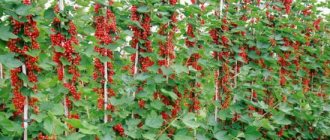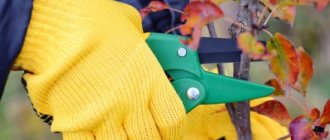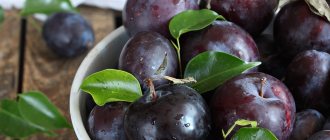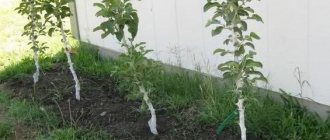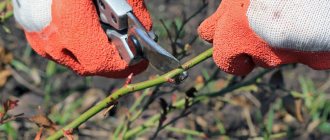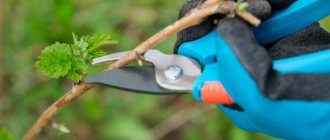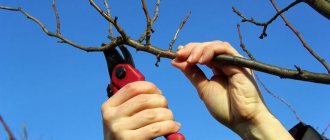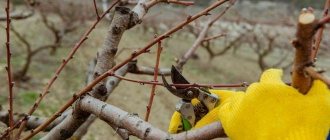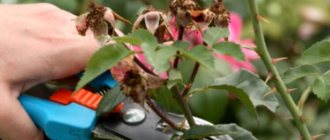Pruning fruit trees is an important agrotechnical activity.
The main goals are tree rejuvenation, sanitary prevention of diseases, crown formation. Dear readers!
For you, we have created communities on social networks in which useful articles and interesting ideas are published several times a day! Subscribe and receive useful content in a convenient format! Plum also requires autumn filing.
In today's article we will discuss the main purposes of plum pruning, patterns and timing of the event in the fall.
Why prune plum trees in the fall?
There are several reasons to prune plum trees in the fall:
- increasing productivity. When there are too many branches on a tree, a lot of nutrients are wasted. Pruning allows you to redirect these microelements to the formation of plums;
- reducing crown density. A plum crown that is too lush makes the tree weaker. It tolerates cold worse. In addition, the branches create a shadow inside the crown, which negatively affects the formation of fruits;
- sanitary purposes. Some shoots may be infected with parasitic larvae or mycelium of pathogenic fungi. To prevent the spread of the disease throughout the tree, such branches need to be sawed off and burned in the fall.
Types of pruning
Pruning happens:
- formative;
- to maintain health;
- rejuvenating;
- to maintain shape.
The plum is usually given a pyramidal shape.
Any plum pruning should be completed in early October in regions with a temperate continental climate (Moscow region and the entire European part of Russia south of it). Otherwise, the tree is in danger of completely freezing.
Anti-aging pruning should be spread over 3–4 years.
Trim levels
In autumn you can completely cut out:
- tops;
- thin thickening branches;
- shoots directed inside the tree;
- twisted rods;
- basal shoots;
- shrunken areas;
- diseased branches;
- greatly expanded competitors;
- overstretched or incorrectly routed conductors.
It is better to cut out thick old branches or harmfully growing branches that were not cut out in time in the summer. If this solves the problem of crown thinning to a large extent, then thin and medium-thick pieces of skeletal branches condemned to be cut out in the next season are cut off.
Disproportionally long branches are shortened. They can break under the weight of snow, fruit, or a person climbing a tree. fast-growing shoots are shortened by 2/3 of their length.
When to prune plums in the fall, choosing the right time
Plum trees are pruned quite early in the fall. The procedure is carried out as soon as the leaves fall. The approximate period is from mid-September to mid-October.
This period is due to the fact that the tree still needs time to prepare for winter. And pruning too late can lead to freezing of the crop.
ON A NOTE. It is better to carry out pruning in the fall on a dry, sunny day, since wet wood is less likely to be sawed. You get jams and chips.
Classification of plum pruning
There are several varieties of plum pruning in the fall.
Sanitary pruning
It is carried out every year 3 years after planting a plum seedling.
In the fall, it is necessary to saw off old, dry, diseased, broken branches. Sanitary pruning also includes removing branches that grow inside the crown and branches that are too close to each other.
Anti-aging pruning with height limitation
Thanks to this pruning, the development of side shoots is activated.
The algorithm is like this:
- The height of the tree is limited to 2 - 2.5 m.
- Dry branches are cut out, as well as those that grow inside the crown.
- Other branches are cut by a third per bud.
- All root shoots are removed.
Regulatory pruning for fruiting
This is the most balanced type of pruning in the fall. You simultaneously create a beautiful crown for the tree and regulate the yield.
The buds at the base of the tree are removed, shoots and fattening branches are broken off.
On young trees, pinch the top above the 5th bud.
Tiered-sparse crown
The most popular type of plum pruning.
The method will be extended over several years. Young trees form skeletal branches, leaving only those shoots that grow in different directions.
This is how branches are cut at each new level.
As a result, the crown allows light and air to pass through well, and many fruits form on the branches.
Bush formation
Plum can be used for decorative purposes and formed into a bush.
In this case, the tree is pruned twice per season: in summer and autumn.
Forming the bowl
- In the year of planting, everything that is above the fifth or seventh bud is cut off.
- Next, shoots are selected. Leave those that grow at an angle of 60 or 90 degrees relative to the trunk. An important clarification: branches should be no lower than 40 cm from the soil level, but not higher than half a meter.
- In subsequent years, the old shoots are pruned and branches of the next order grow on them.
Is it possible to do without pruning?
Pruning a pear in the fall - how to prune correctly
Regular pruning is a fundamental element of proper care of trees and shrubs in your garden. Depending on the pruning method used, the timing of the work, and the age of the plants, different results can be achieved.
Regular plum pruning
The main goals of the event are:
- obtaining a healthy tree that can bear fruit annually;
- creating a strong skeleton;
- maintaining a beautiful crown;
- creating light in the crown for the normal development of the seedling;
- the ability to regulate growth and fruiting;
- increasing the quality of plums;
- easier harvesting;
- reducing the risk of diseases and the number of pests;
- creating the necessary conditions for plant growth and fruiting at different periods of the tree’s life;
- rejuvenation.
If you leave pruning for later, the trees will be very tall, with a spreading, unkempt crown, and with small fruits. In addition, this will lead to a decrease in the winter hardiness of plants.
Methods for shaping plums
There are 3 main ways to shape plums in the fall: on a ring, on a bud and on a shoot.
Let's take a closer look at them.
On the ring
The essence of the method is to trim the plum branch so that a “ring” is formed at the shoot site.
This method of filing is necessary to remove excess shoots. Pruning is carried out along the annular bead, but in such a way that a stump does not form.
On the kidney
Pruning on a bud in the fall is done in order to direct the growth of shoots in the desired direction in the spring and form a crown.
Pruning is carried out on one-year-old shoots. Cut the branch at an angle of 45 degrees just above the bud, which faces in the direction we need.
To the side escape
In this case, branches are cut down from the old crown.
This method is necessary in order to stimulate the development of new side shoots on the plum.
By filing a side shoot, you can extend the fruiting period of a plum tree by several years.
Pruning columnar plum
Columnar plum is distinguished by the almost complete absence of lateral shoots. Their length does not exceed 15–20 cm. Therefore, pruning in this case is kept to a minimum. Basically, the gardener will be required to remove branches damaged by frost, pests, gusts of wind, and so on.
The crown of the columnar plum consists of very short shoots, so it does not require special shaping
Under no circumstances should you touch the central conductor of such trees; the growth point is located there. Otherwise, the plum will begin to branch and gradually turn into an ordinary tree, albeit with a lower yield.
Thanks to the characteristic crown configuration, the columnar plum looks very impressive and takes up very little space in the garden.
The only exception is if the apical bud is seriously damaged by frost. As a rule, in this case, on a columnar plum tree, 2–3 additional shoots are formed near the top. You can immediately select one of them, the most powerful, and delete the rest. There is another option - wait another season to see which branch will develop more actively. This will become clear next spring, when they reach a length of 20–25 cm. Unnecessary shoots are cut off (this is quite suitable material for grafting), the remaining one replaces the central conductor.
Pruning plums in the fall - diagrams for beginners in pictures step by step
The algorithm for pruning plum trees in the fall is quite simple. For a beginner, it is better to use the simplest scheme.
- We cut off dry branches, as well as those shoots that interfere with each other and have broken off due to the wind and the weight of the fruit.
- We optionally trim the top if it has grown too long.
- We prune competing branches. These are shoots that grow in one direction and interfere with each other. We also cut out those branches that grow inside the crown.
- During the first pruning, the trunk is shortened by a third, and the skeletal branches by two thirds.
- Finally, we prune the branches that are growing too quickly. This will relieve the plum crown.
- We treat the cuts with garden varnish.
- We feed the tree and mulch the tree trunk.
Rules for forming a plum
Each manipulation carried out with trees has its own rules. To obtain healthy plants and a rich harvest, only garden pruning shears are used. It is forbidden to break branches, this will reduce immunity. Disinfect instruments before performing the procedure.
Attention!
Removed branches must be burned, as plum parasites may appear there. They can spread to healthy trees, which will not have the best effect on the harvest.
Branches that grow inward must be removed. Weather conditions must be:
- dry;
- warm (temperature should be about 10 ° C).
The crown must be thinned annually and step by step. This stimulates protection from cold weather and a bountiful harvest. Finally, you can feed it with fertilizers. Feeding plums in the fall will have a beneficial effect on the harvest in the summer.
A gardener's arsenal should include the following tools:
- hacksaw;
- garden knife;
- pruner
Before pruning, all tools must be disinfected. Especially if they were previously used on sick and contaminated crops.
Diseases can be transmitted from one tree to another. The tool must be sharpened well to prevent frayed cuts on the branches. Such areas will take a very long time to heal. Skeletal branches are cut using a hacksaw. A knife is needed to remove young shoots. Before work, you can practice on unnecessary rods. This will cause less damage.
Secateurs are perhaps the most indispensable tool in a gardener's arsenal. They can be used to remove thick branches. The pruning shears must be sharpened regularly to avoid damaging the cutting area.
How to prune a young plum in the fall
Sawing of a young plum begins already in the first year of planting the tree.
Usually the top is shortened to stimulate the growth of side shoots and stop the tree from growing upward.
IMPORTANT! You cannot saw off more than a third of the seedling.
Experienced summer residents advise cutting off all shoots that are below the 0.5 m mark.
They leave branches that grow in different directions. This way they will not interfere with each other and will form a beautiful crown.
Autumn pruning of old plums
On old plums, the crown is formed up to the fifteenth anniversary. Next, the tree is completely cut down, freeing up space for new seedlings, or only sanitary pruning is carried out.
Old plum trees have large branches that can break off from snow and wind. They are cut to approximately 30% of their length.
Also in the fall, all shoots that have been damaged or broken are cut down. Be sure to remove dry branches. All this will protect the plum from freezing.
However, try not to overdo it. The loss of a large number of shoots can lead to the death of the plant. It is better to spread the pruning over several years, sawing off several large branches per year.
IMPORTANT! Sawn shoots must be burned.
What tools are needed to carry out the procedure correctly?
To make it convenient to work and cause the least harm to the plum, you need to prepare a working tool.
You will need gloves as plums have short, sharp shoots that can scratch your hands. For the same reason, we recommend using safety glasses and working in overalls.
You may need a stepladder if you are working with a mature plum tree.
Useful cutting tools include garden pruning shears, a hacksaw, and a lopper.
IMPORTANT! All tools must be well sharpened!
Also prepare paste or garden varnish, since the cuts must be processed. Untreated cuts can easily become a source of disease infection.
Rules and schemes for crown formation
There are several options for crown formation. They are selected depending on the age of the tree and the desired type of plant in the future.
young tree
It is not recommended to prune seedlings immediately after planting. It is best to plant an annual seedling in the spring that has several side shoots. Before planting, a special support is installed for the seedling, to which it is then tied. The very first pruning should be done a year later, in March.
The first pruning is done when the buds begin to appear, usually around mid-March. Pruning of young trees is carried out according to the following scheme:
- First of all, all branches on the main trunk are cut off at a level of 45–50 cm from the ground and below;
- The remaining branches are cut only in half. In the future they will form the frame of the tree;
- The central trunk is cut so that it remains no more than 1.5 m in height.
The next pruning is done in July. All side shoots from the trunk are shortened to 20 cm. Side shoots on the branches are shortened to 15 cm. The central trunk is left unchanged. In the second years, formative trimming of the crown is performed.
Fruiting plum
In the third and subsequent years, the plum tree becomes a mature, strong tree and its pruning becomes easier. The central trunk is shortened to 2.5 m. New growth is cut upward. It is also necessary to remove all dried, damaged and diseased shoots. When pruning in summer, side shoots are pinched to a length of 20 cm. All intersecting branches should also be cut off.
Pruning of a fruiting plum is necessary for proper formation of the top.
The most important thing here is to form the top correctly. To do this, all improperly growing stems are cut to the ground. You should focus on your preferred shape - a pyramid, a bowl or something else.
The procedure for pruning a young tree is the most difficult; in the future, everything is much simpler; in mature trees, only dried, damaged or improperly growing branches are removed.
Stages of anti-aging pruning
Experienced gardeners advise performing plum pruning procedures within 15 years from the date of planting. The second criterion for finishing pruning is that the tree reaches its maximum height - up to 3 m. After this, the trunk and rapidly growing shoots are only shortened.
For old trees, pruning is carried out according to the rejuvenation scheme. At the same time, cut off all branches that are sick or dry. The young shoots are left to grow unchanged. Such a plum will produce a good harvest for many years to come, even despite its advanced age.
The best time for anti-aging pruning is early spring. First of all, the frame branches are removed; they are thicker than ordinary shoots, so they are cut down, having previously been trimmed on both sides. This way the branches will not break off under their own weight during cutting, and the cuts themselves will be smoother. At the same time, it is important to know that the tree tolerates sawn and cut branches more easily than broken ones; this is another reason to prune and not let everything take its course. All saw cuts must be treated with charcoal or garden pitch.
In the summer, new shoots will appear in place of the cut branches, of which it is worth leaving 2 - 3 of the strongest ones and removing the rest. To avoid putting unnecessary stress on the tree.
As a rule, anti-aging pruning is divided into stages, which in total last for three to four years. The fact is that if all the necessary procedures are performed in one season, the plant may die.
Caring for plums after pruning
After work, the plum needs to be properly cared for so that pruning does not cause disease or even death of the tree.
Therefore, you will need garden pitch or paste. It is used to process cuts of all branches with a diameter greater than 3 cm.
It is also advisable to feed the plum after the procedure. For this purpose, potassium fertilizers and phosphates are used. Most often it is superphosphate and potassium chloride.
Mix 3 tablespoons of superphosphate and 2 tablespoons of potassium chloride in a bucket of water. Water the tree trunk circle with this mixture. After which mulching is carried out.
Common Mistakes
Improperly formed plum crown will lead to problems with the tree in the future - diseases, poor quality of fruits, lack of harvest, etc. Typical mistakes include:
- Delay in the start of pruning - formation begins the next year after planting. Lost time will make booking difficult, because... mature shoots cannot be bent, they can only be removed, and simultaneous cutting of several large branches can cause stress in the tree.
- Failure to meet deadlines - pruning plums in the spring is most favorable. In summer and autumn, only sanitary pruning can be carried out.
- Incorrect technique. The cut to the bud is made just above its top at an angle. Trimming into a ring is done as close as possible to the annular thickening, but without injuring it.
A common mistake in this case is leaving the stump. In the future, it will become a weak point of the tree - open tissue that does not overgrow is susceptible to frost, fungi and pests. Top shoots will grow from the stump every year until it dries out.
- Use of low-quality tools and disinfectants, poor quality of work. Secateurs and hacksaws must be sharp to prevent shoot fracture and peeling of the bark. To protect the cut, use garden varnish or other disinfectants - special paint or paste.
- Incomplete pruning - gardeners are often afraid to prune shoots for fear of not getting enough harvest. This approach is fundamentally wrong, since it helps the plum to correctly redistribute nutrients in favor of fruit-bearing branches, and as a result, get a good harvest.
Insufficient ventilation and illumination of the crown often causes the spread of diseases and weakening of the tree’s immunity, and shoots growing at an acute angle in the future may break off under the weight of the fruit.
If you have any questions, we are always happy to discuss them in the comments and our groups on social networks.
Common mistakes
Let's figure out what novice gardeners most often make mistakes when pruning plum trees in the fall.
- Pruning the plum tree is done too late. It is necessary to saw off excess branches at least a month before the onset of cold weather. This is exactly how long it takes for a plum to “lick its wounds.” If pruning is done too late, the tree may die.
- The plum is sawn until the leaves fall off. Pruning during the growing season is a lot of stress for the tree. Any mistake made can lead to drying out of the tree.
- Sloppy cuts. To reduce the risk of injury to cuts, they must be done very carefully. Avoid chipping. If you are cutting a thick branch, make a small cut from the bottom first. Be sure to use well-sharpened garden tools (lopper, hacksaw, pruning shears, garden shears).
- In the fall, too many branches are cut at once. Because of this, the tree may die. Do not file many branches at once. It’s better to spread out rejuvenation over several seasons.
- The cuts are not treated with garden varnish. An untreated cut is a potentially dangerous place. Through it, an infection can enter the tree.
- Pruning is carried out haphazardly. Do not file down all the shoots in a row. Clearly imagine the scheme according to which you carry out the work.
Timing of pruning and specifics of seasonal work
Choosing the timing of pruning depending on the season has its own principles and advantages, depending on the climate zone, condition and age of the tree. In the southern regions, it is preferable to care for the plant in the fall, although there it is permissible to engage in shaping almost all year round. In the northern and central regions, it is better to hold the event in spring or summer.
Spring booking
The beginning of spring is the best time to work. At this time, pruning is easier to tolerate, which stimulates the formation of buds. The plum tree begins to vegetate one of the first in the garden, so it is important to begin the procedure before it begins. Exact times vary by region. Gardeners are guided by the development of buds and the weather, when the night frosts have receded, but active sap flow has not yet begun and the buds have not swollen. The formation of a seedling and the rejuvenation of an adult representative should be completed about a month before bud break.
In the case of sanitary treatment with the removal of diseased, frozen and dry parts, there are no time limits. Unleafed twigs make it easier to determine which ones need to be removed.
If the plums in the garden are of different ages, then it is preferable to start working with the older individuals. With age, the plant's flower buds awaken earlier.
It is more convenient to split the event into two stages. First, thickened areas are thinned out to remove excess growth and upward growing tops. For adult pets, bitches that have sunk to the ground can be transferred to new branches. Then you need to start shortening last year’s growth of young seedlings. This promotes fouling of fruit links and accelerates the entry into fruiting.
Summer booking
Summer is the active season when the garden sets fruit. As a rule, it is not customary to rejuvenate and form fruit crops at this time. However, the plum tolerates summer intervention well. Summer pruning by removing fattening tops helps redirect nutrition to fruit-bearing branches. Also, throughout the entire season, root shoots are cut out so that no protruding stumps remain below ground level and in the trunk. Opening hours: June and July. At the end of the month, the side branches of seedlings of the first and second years are shortened, without touching the central conductor.
The leafy top allows you to notice thickening, which will allow you to plan subsequent pruning during the dormant period. But the frozen sprouts, unnoticed in the spring, will be discovered right now.
Secateurs will be needed throughout the season and for sanitary processing. Timely preventative removal of infected shoots will help avoid the spread of the disease, ensuring a healthy garden.
Autumn booking
You can’t ignore autumn pruning. The main task of this season is to prepare the crop for the winter cold. To do this, remove all broken, diseased and immature shoots that are prone to freezing. You can remove branches and tops that are too long, which can break due to frost, heavy snowfall or gusty winds. If diseased or dry growth must be cut out, then the formation of a crown with thinning is permissible only in the southern zone with a long autumn. Seasonal intervention due to reduced healing increases the risk of crop freezing. In the northern and central regions, it is better to postpone events to spring.
Answers to frequently asked questions
In conclusion, a selection of the most common questions about pruning plum trees in the fall.
When to prune plums after harvest
Immediately after collecting all the plums from the tree, it is still too early to prune. The tree has not yet gone dormant, which means pruning can harm it.
It is necessary to remove branches after the leaves have fallen from the tree. In different Russian regions it is necessary at different times. On average it is mid-September - October.
When to prune plums in September
In September it is not always possible to saw down a plum tree. If there are still leaves on it, then it is better to postpone the procedure to a later date.
The main thing is to follow the rule “Do no harm.” It’s better to postpone pruning until spring, rather than injure the tree and have it freeze in winter.
When to prune in Siberia
In the Siberian region, pruning should be done in early autumn. If you missed this moment, then it’s better not to risk it and postpone the procedure to spring.
If the tree does not have time to heal the wounds from the cuts before the onset of frost, then it may simply not survive the winter.
Purpose of the procedure
Not only the appearance of fruits, but also the overall health of the plum depends on pruning. To avoid cutting off good branches and weakening the plant, you should follow simple rules.
Preventative pruning of plums in the autumn is carried out for several purposes:
- To regulate the direction of branch growth.
- For sanitary treatment of wood.
- To give shape to the crown and skeletal branches, if these manipulations were not completed in the spring.
- To prepare plums for winter cold.
- For shortening shoots that have begun to grow too early.
